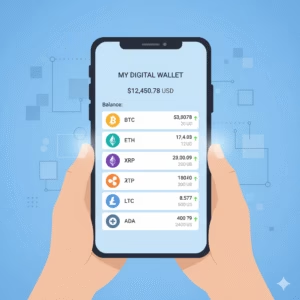How Cryptocurrency Exchanges Differ from Stock Exchanges
Understand how crypto brokers work differently than stock and fund brokers

On the surface, they look almost identical.
You open an app, see a chart with green and red lines, type in a ticker (like ‘AAPL’ or ‘BTC’), and click “Buy.” It’s easy to assume that a modern stock brokerage and a cryptocurrency exchange are just different flavors of the same thing.
This assumption is one of the most dangerous—and potentially costly—mistakes a new investor can make.
While both platforms allow you to trade assets, the plumbing behind the app is fundamentally different. One is a 100-year-old, highly regulated system built on consumer protection and legal ownership. The other is a 15-year-old technological revolution built on decentralized code and the principle of “be your own bank.”
Understanding the vast differences in regulation, insurance, custody, and risk isn’t just academic. It’s the only way to truly know who owns your assets and how safe your money really is.
What Are You Actually Buying? The Great Asset Divide

The first difference is the most fundamental: the assets themselves.
With a Stock Broker:
You are buying stocks (or shares). A single share of a company like Apple (AAPL) or Amazon (AMZN) represents a tiny, legally-recognized piece of ownership in that corporation.
You have legal rights as a shareholder. You may be entitled to vote on company matters or receive a portion of the profits in the form of dividends. The value of your stock is, in theory, tied to the company’s real-world performance: its profits, assets, revenue, and future growth prospects. It’s all governed by centuries of established corporate and securities law.
With a Crypto Exchange:
You are buying digital assets. “Cryptocurrency” is a catch-all term for thousands of different types of tokens, each with a different purpose. For example:
- Currencies/Stores of Value: Bitcoin (BTC) is the most famous, designed as a decentralized digital currency and often compared to “digital gold.”
- Utility Tokens: Ethereum (ETH) isn’t just a currency; it’s “gas” used to pay for computations on the Ethereum “world computer,” a platform that runs decentralized applications (dApps).
- Stablecoins: USD Coin (USDC) or Tether (USDT) are tokens designed to be “pegged” 1-to-1 with a real-world asset, like the U.S. dollar.
- Memecoins: Assets like Dogecoin (DOGE) often have no underlying utility or value proposition and are driven entirely by community hype and speculation.
When you buy a crypto asset, you are not buying ownership in a company. You are buying a piece of code, a unit of a network, or a digital key that unlocks a specific function.
The “Wild West” vs. the “Walled Garden”: Understanding the Massive Regulatory Gap
This is arguably the most critical difference every investor must understand.
The Stock Broker’s “Walled Garden”
When you open an account with a U.S. stock broker (like Fidelity, Charles Schwab, or Vanguard), you are entering one of the most heavily regulated financial ecosystems on earth.
- SEC (Securities and Exchange Commission): This is the top federal watchdog. The SEC enforces laws against fraud and insider trading. It requires public companies to provide massive, standardized disclosures (like quarterly earnings reports and annual 10-K filings) so all investors have access to the same information.
- FINRA (Financial Industry Regulatory Authority): This is the non-profit organization that regulates broker-dealers day-to-day. It audits brokerage firms, licenses individual brokers, and ensures firms are following rules designed to protect investors. You can use FINRA’s “BrokerCheck” tool to see the history and license of any broker.
The result: This is a system built on transparency and rules. While you can still lose money from a bad investment, you are protected from outright fraud and broker misconduct in a way that is standardized and legally enforceable.
The Crypto Exchange’s “Wild West”
The regulatory landscape for crypto in the U.S. is, to put it mildly, a chaotic and evolving mess. There is no single, clear-cut regulator.
- A “Patchwork” System: The SEC and the CFTC (Commodity Futures Trading Commission) are in a legal “turf war.” The SEC claims most crypto assets are unregistered securities and is actively suing major exchanges (like Coinbase and Binance) for illegally selling them. The CFTC argues that assets like Bitcoin are commodities (like gold or corn) and should fall under its jurisdiction.
- No Investor Disclosures: There is no legal requirement for a crypto project to file a quarterly earnings report or disclose who its major “insiders” are. The “whitepaper” for a new token is a marketing document, not a legally-binding prospectus.
- State-by-State Rules: To make matters more confusing, some states (like New York, with its strict “BitLicense”) have their own set of rules, creating a fragmented map of what’s allowed where.
The result: You are operating with far less information and protection. A crypto asset can be delisted overnight by an exchange. An exchange can be sued by the SEC, putting all its assets in limbo. The rules are being written as the game is being played.
Is Your Money Insured? The $500,000 Difference (SIPC vs. Nothing)

This is the multi-trillion-dollar question. What happens if the platform you use goes bankrupt?
Stock Broker: SIPC and FDIC Protection
With a legitimate U.S. stock broker, you have two powerful layers of insurance, completely free.
- SIPC (Securities Investor Protection Corporation): This is the most important protection you have. SIPC is a non-profit corporation created by Congress. If your brokerage firm fails (goes bankrupt) and your securities are missing from your account (due to theft, fraud, or mismanagement), SIPC steps in to make you whole.
- It protects up to $500,000 in total value per customer.
- This includes a $250,000 limit for uninvested cash.
- Crucially: This is not market insurance. If you buy a stock for $100 and it drops to $10, SIPC does not help. But if your broker collapses, SIPC ensures you get your $10 stock back.
- FDIC (Federal Deposit Insurance Corporation): This is for your uninvested cash. As we covered in a previous article, brokers “sweep” your cash into partner banks. That cash is typically FDIC-insured, protecting you up to $250,000 (or more) if one of those banks fails.
Crypto Exchange: The Terrifying Truth
With a crypto exchange, your protection is dramatically different and vastly lower.
- SIPC: ZERO. SIPC has stated publicly and repeatedly that it does not protect cryptocurrency. If you hold $100,000 in Bitcoin on an exchange and that exchange goes bankrupt (like FTX, Celsius, or Voyager), your SIPC protection is $0. You become an “unsecured creditor” in a bankruptcy proceeding. You will have to wait in line for years and will likely only get back pennies on the dollar.
- FDIC: This insurance ONLY applies to the U.S. Dollar (USD) cash balance sitting in your account. It DOES NOT cover your crypto. Critically, it also DOES NOT cover stablecoins like USDC or USDT. Many investors mistakenly believe their $50,000 in USDC is “cash,” but from an insurance perspective, it’s just another unprotected digital token.
- Private Insurance: Some large exchanges (like Coinbase) purchase private insurance policies. This is not the same as SIPC. This insurance typically only covers assets stolen from the exchange’s “hot wallets” (online storage) by an external hacker. It does NOT cover:
- Company bankruptcy.
- Internal fraud or theft (i.e., the company stealing your money).
- You being personally scammed or phished.
“Not Your Keys, Not Your Coins”: The Revolution of Digital Custody
How your assets are “held” is another night-and-day difference.
Stock Brokers:
When you buy a stock, you don’t receive a paper certificate. The stock is held in “street name,” meaning the brokerage holds it on your behalf. All these stocks are centrally located at a depository, like the Depository Trust Company (DTC). This is a highly regulated, centralized, and trusted system. You are the “beneficial owner,” and your broker is the “custodian.”
Crypto Exchanges:
This is where crypto’s entire philosophy comes into play.
- On-Exchange (Custodial Wallet): When you buy Bitcoin on an exchange, you are doing the same as with a stock: you are trusting the exchange to hold it for you. This is convenient but comes with all the risks we just mentioned (bankruptcy, theft). This leads to the most famous saying in crypto: “Not your keys, not your coins.” If it’s on an exchange, you don’t truly own it; you have an IOU from the exchange.
- Self-Custody (Non-Custodial Wallet): This is crypto’s superpower. You have the option to withdraw your assets from the exchange to your own “wallet.” This can be a software wallet on your phone (like MetaMask) or a hardware wallet (like a Ledger or Trezor device), which is a small USB drive.
- When you do this, you—and only you—control the “private keys,” the master password to your funds. You are now 100% in control. No company can go bankrupt and take your money.
- The Catch: This also means you are 100% responsible. If you lose your private keys or get phished, there is no “Forgot Password” link. There is no 1-800 number to call. The money is gone, permanently and irretrievably. This concept has no equivalent in the stock world.
24/7/365 Chaos vs. 9-to-5 Order: Why Market Hours Matter

The trading schedules themselves reveal the different natures of these assets.
Stock Brokers:
The U.S. stock market operates on a civilized schedule: 9:30 AM to 4:00 PM ET, Monday through Friday. It’s closed on weekends and federal holidays.
- Implications: This structure provides stability. Major company news (like earnings) is often released “after hours” so investors can digest it before the market opens. If the market crashes too fast, “circuit breakers” automatically halt trading to prevent panic. You can sleep at night.
Crypto Exchanges:
The crypto market never closes. It is a 24/7/365 global market.
- Implications: This creates constant, unrelenting volatility. A 40% crash can (and does) happen at 3:00 AM on a Sunday. This creates immense psychological pressure to be “always on” and can lead to sleepless nights and reactive, emotional decisions. There are no global, market-wide circuit breakers to stop the panic.
Unpacking the Fee Structures: Is “Free” Really Free?
This is another area where “free” means very different things.
Stock Brokers:
The industry standard is now “zero commission” trading. This is great for investors but means brokers make money in other ways:
- Payment for Order Flow (PFOF): They route your trade to a high-frequency trading firm (a “market maker”) who pays the broker for the “order flow.” The market maker executes the trade and profits from the tiny “bid-ask spread.”
- Net Interest Margin: As detailed previously, they earn significant interest on your uninvested cash by paying you a tiny APY.
- Margin Lending: They charge high interest rates when you borrow money to invest.
Crypto Exchanges:
Fees are typically much higher and more complex.
- The “Spread”: This is the #1 hidden fee on “easy” apps. The price you buy at is intentionally higher than the price you can sell at at the exact same moment. This spread is pure profit for the exchange.
- Maker/Taker Fees: “Pro” platforms use this model. You are a “taker” if you buy at the current market price (high fee). You are a “maker” if you place a limit order that isn’t filled immediately (low fee).
- Withdrawal Fees: Exchanges charge you a flat fee to move your crypto to your own wallet.
- Network Fees (“Gas”): This is not an exchange fee, but a blockchain fee. To move assets (especially on Ethereum), you must pay a “gas” fee to the network’s validators, which can range from a few cents to hundreds of dollars depending on congestion.
The New Hybrids: What About Apps That Offer Both?
Platforms like Robinhood and Webull have blurred the lines by offering both stocks and crypto in the same app. This is a massive point of confusion.
Here is the critical takeaway: The protections DO NOT cross over.
When you buy a share of ‘AAPL’ on Robinhood, that stock is SIPC-protected.
When you buy ‘BTC’ on that same app, it is NOT SIPC-protected.
This is disclosed in the user agreement, but it’s the fine print most people skip. For a long time, many of these “hybrid” apps didn’t even allow you to withdraw your crypto to a self-custody wallet, meaning you were 100% exposed to their platform risk. While that is changing, it highlights the fact that they are treating these two asset classes in completely separate legal and technical silos.
Two Platforms, Two Worlds

The convenience of a smartphone app has masked the reality that a stock broker and a crypto exchange are not just different companies; they are gateways to different financial universes.
- A Stock Broker is a regulated, insured, and centralized service for buying legal ownership in the traditional financial system.
- A Crypto Exchange is a lightly regulated, uninsured, and digital-native marketplace for accessing a new, parallel financial system.
The primary risk in stock investing is market risk—you pick a bad company that loses value.
The primary risks in crypto investing are platform risk (your exchange goes bankrupt), custodial risk (you lose your private keys), and regulatory risk (a government action erases a project overnight), all before you even get to the extreme market volatility.
Both can be part of a modern portfolio, but only an investor who understands these profound differences can navigate them safely.





